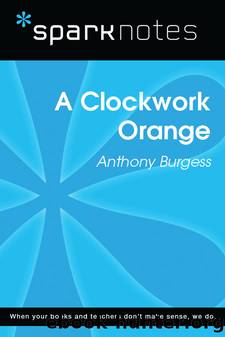A Clockwork Orange: SparkNotes Literature Guide by SparkNotes

Author:SparkNotes [Sparknotes Editors]
Language: eng
Format: epub
Tags: Study Guides
ISBN: 9781411474468
Publisher: Spark
Published: 2014-09-10T00:00:00+00:00
Analysis
Alexâs second murder occurs under very different circumstances from the first, but it highlights many of the same character traits. In both the cases of the cat-lady and the new prisoner, Alex displays a blatant lack of compunction as well as a steady reliance on impulse and intuition to guide his reactions. These attributes drive the plot, since they are responsible for both his incarceration and his release. While Alexâs impulsive attraction to the Beethoven bust allows him to be captured, the reckless delight in violence that the Minister calls the âcriminal reflexâ subsequently gets Alex out of prison. Itâs also important to note that these two murders suggest a less obvious, but no less important, aspect of Alexâs character. If death is not an unwelcome consequence of Alexâs crimes, it certainly is an unintended one. Even in his fantasies, Alex never connects death with violence. Alexâs neutral stance on death highlights a strong commitment to living, albeit in a somewhat warped manner. Death equates to inaction, and this is the very opposite of what thrills Alex.
The Ministerâs speech in Chapter 2 provides a rare glimpse into the normally obscure inner workings of the government. By mentioning the need to make room for âpolitical offendersâ in the Stateâs prisons, the Minister insinuates that the government anticipates a period of increased political dissent. It seems reasonable, then, to assume that the government is about to undergo some kind of major transition, during which it will become even less tolerant of criticism and opposition. At this point, Alexâs new position as a pawn of the State comes into play. The new Minister, whom the Governor refers to as âa very new broom,â plans to sweep typical criminalâthieves, murderers, and violent offendersâout of the jails by treating them on a âcurative basis.â Alex represents an ideal test case for this rehabilitative treatment since, as a young killer who stalks the streets at night, Alex represents many citizensâ greatest fears. If the State can successfully neutralize the threat posed by Alex and other young thugs like him, it can expect to parlay the citizensâ deep gratitude and new sense of security into political currency, thereby defusing the threat of insurgency as it makes its administrative transition.
The Ministerâs disenchantment with what he calls âoutmoded penological theoriesâ (i.e., imprisonment) is ironic, since it is the Stateâs own laxness on crime that has allowed prisons to become so dangerous and overcrowded in the first place. Early in the novel, Alex notes that there are significantly fewer policemen patrolling the streets at night, and those same officers only manage to apprehend Alex because his friends betray him. The State has insidiously indulged, possibly even encouraged, juvenile crime in the past because it keeps other citizens in a state of fear. But now, as it prepares for a period of even greater dominance, the State plans to use new technology to remove the juvenile threat, which represents not only a volatile social force, but also a negative public relations campaign for the government.
Download
This site does not store any files on its server. We only index and link to content provided by other sites. Please contact the content providers to delete copyright contents if any and email us, we'll remove relevant links or contents immediately.
Fresh from the Country by Miss Read & Brian Flynn(374)
If Only It Were True by Marc Levy(349)
The Road of Bones to the Arctic Gulag by Anthony Vincent Bruno(217)
Complete Works of Winston Churchill by Winston Churchill(215)
A House Full of Men by Parinda Joshi(190)
How to Draw Manga. Vol. V. Drawing Female Characters by Unknown(180)
Chronicles of Sherlock Holmes by David B. Beckwith(178)
John Dough And The Cherub (1906) (L. Frank Baum) by Unknown(178)
All-Time Best Recipes: From the first 100 issues of America's most reliable food magazine by The Editors of Cook's Illustrated Magazine(175)
Beethoven's Assassins by Andrew Crumey;(170)
0ffbef875ab23ff252e71f7c48b9c417 by Franz Kafka & Kafka Franz(170)
Hawthorne, Nathaniel Hawthorne by The house of seven gables(167)
The Reincarnationist Papers by Eric Maikranz(157)
The Four Seasons Collection by Milly Johnson(153)
The Fair Maid of Perth by Sir Walter Scott (Illustrated) by Sir Walter Scott(153)
The Ghosts of Meenambakkam by Ashokamitran(145)
Kidnapped by Henry Brook(134)
Tuesday Evenings with the Copeton Craft Resistance by Kate Solly(134)
To the Very Last Inch by Heidi Belleau(132)
